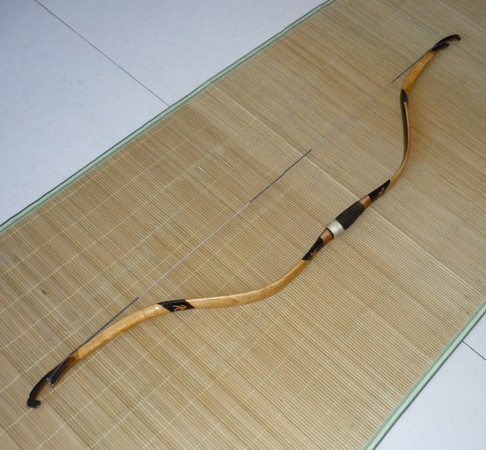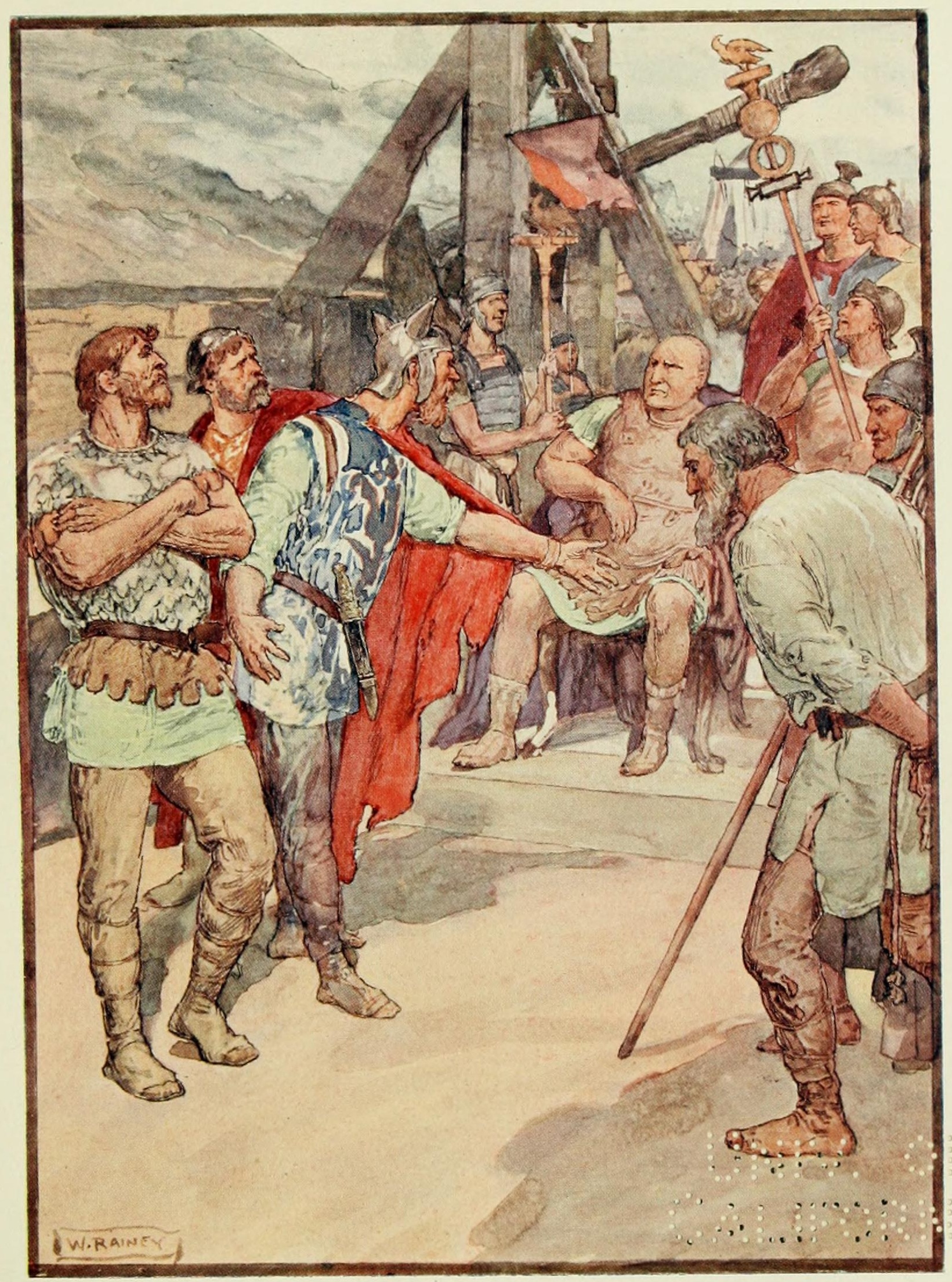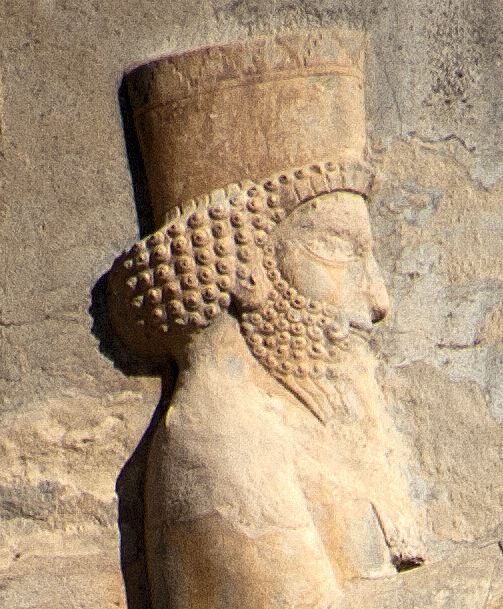|
Cretan Archers
Cretan archers were a well known class of warrior whose specialist skills were extensively utilized in both ancient and medieval warfare. They were especially valued in armies, such as those of the Greek city-states, (such as Athens, Sparta, Eretria, and Macedonia) and those of ancient Rome, which could not draw upon substantial numbers of skilled archers from their native populations. Normally Greek archers fought unarmored, yet some sources show archers wearing Linothorax or leather armor (like on the Nereid Monument), helmets, or even where cuirassed. Ancient Cretan archers were said to also wear small shields, which implies, that they were capable of defending themselves in melee combat. This also implies that they were probably also equipped with swords. Due to the mass of Cretan archers in use during the Hellenistic era it is possible, that at least in some cases, "Cretan" means "in the Cretan fashion", like "Tarantine" in Tarantine cavalry often denotes a type of tactics ... [...More Info...] [...Related Items...] OR: [Wikipedia] [Google] [Baidu] |
Crete
Crete ( el, Κρήτη, translit=, Modern: , Ancient: ) is the largest and most populous of the Greek islands, the 88th largest island in the world and the fifth largest island in the Mediterranean Sea, after Sicily, Sardinia, Cyprus, and Corsica. Crete rests about south of the Greek mainland, and about southwest of Anatolia. Crete has an area of and a coastline of 1,046 km (650 mi). It bounds the southern border of the Aegean Sea, with the Sea of Crete (or North Cretan Sea) to the north and the Libyan Sea (or South Cretan Sea) to the south. Crete and a number of islands and islets that surround it constitute the Region of Crete ( el, Περιφέρεια Κρήτης, links=no), which is the southernmost of the 13 top-level administrative units of Greece, and the fifth most populous of Greece's regions. Its capital and largest city is Heraklion, on the north shore of the island. , the region had a population of 636,504. The Dodecanese are located to the no ... [...More Info...] [...Related Items...] OR: [Wikipedia] [Google] [Baidu] |
Composite Bow
A composite bow is a traditional bow made from horn, wood, and sinew laminated together, a form of laminated bow. The horn is on the belly, facing the archer, and sinew on the outer side of a wooden core. When the bow is drawn, the sinew (stretched on the outside) and horn (compressed on the inside) store more energy than wood for the same length of bow. The strength can be made similar to that of all-wood "self" bows, with similar draw-length and therefore a similar amount of energy delivered to the arrow from a much shorter bow. However, making a composite bow requires more varieties of material than a self bow, its construction takes much more time, and the finished bow is more sensitive to moisture. Archaeological finds and art indicate composite bows have existed since the second millennium BCE, but their history is not well recorded, being developed by cultures without a written tradition. They originated among Asiatic pastoralists who used them as daily necessities, clas ... [...More Info...] [...Related Items...] OR: [Wikipedia] [Google] [Baidu] |
Cohors I Cretum Sagittaria
Cohors rimaCretum uingenaria peditatasagittaria (" st infantry 500 strongarcher cohort of Cretans") was a Roman auxiliary archers regiment. The cohort was stationed in Dacia at castra Drobeta. See also * List of Roman auxiliary regiments This article lists ', non-legionary auxiliary regiments of the imperial Roman army, attested in the epigraphic record, by Roman province of deployment during the reign of emperor Hadrian ( AD 117–138). The index of regimental names expla ... References * Academia Română: Istoria Românilor, Vol. 2, Daco-romani, romanici, alogeni, 2nd. Ed., București, 2010, * Cristian M. Vlădescu: Fortificațiile romane din Dacia Inferior, Craiova, 1986 Military of ancient Rome Auxiliary peditata units of ancient Rome Roman Dacia Ancient Crete Ancient Greek archers {{AncientRome-mil-stub ... [...More Info...] [...Related Items...] OR: [Wikipedia] [Google] [Baidu] |
Roman Empire
The Roman Empire ( la, Imperium Romanum ; grc-gre, Βασιλεία τῶν Ῥωμαίων, Basileía tôn Rhōmaíōn) was the post-Republican period of ancient Rome. As a polity, it included large territorial holdings around the Mediterranean Sea in Europe, North Africa, and Western Asia, and was ruled by emperors. From the accession of Caesar Augustus as the first Roman emperor to the military anarchy of the 3rd century, it was a Principate with Italia as the metropole of its provinces and the city of Rome as its sole capital. The Empire was later ruled by multiple emperors who shared control over the Western Roman Empire and the Eastern Roman Empire. The city of Rome remained the nominal capital of both parts until AD 476 when the imperial insignia were sent to Constantinople following the capture of the Western capital of Ravenna by the Germanic barbarians. The adoption of Christianity as the state church of the Roman Empire in AD 380 and the fall of the Western ... [...More Info...] [...Related Items...] OR: [Wikipedia] [Google] [Baidu] |
Roman Republic
The Roman Republic ( la, Res publica Romana ) was a form of government of Rome and the era of the classical Roman civilization when it was run through public representation of the Roman people. Beginning with the overthrow of the Roman Kingdom (traditionally dated to 509 BC) and ending in 27 BC with the establishment of the Roman Empire, Rome's control rapidly expanded during this period—from the city's immediate surroundings to hegemony over the entire Mediterranean world. Roman society under the Republic was primarily a cultural mix of Latin and Etruscan societies, as well as of Sabine, Oscan, and Greek cultural elements, which is especially visible in the Roman Pantheon. Its political organization developed, at around the same time as direct democracy in Ancient Greece, with collective and annual magistracies, overseen by a senate. The top magistrates were the two consuls, who had an extensive range of executive, legislative, judicial, military, and religious powers ... [...More Info...] [...Related Items...] OR: [Wikipedia] [Google] [Baidu] |
Gaius Marius
Gaius Marius (; – 13 January 86 BC) was a Roman general and statesman. Victor of the Cimbric and Jugurthine wars, he held the office of consul an unprecedented seven times during his career. He was also noted for his important reforms of Roman armies. He set the precedent for the shift from the militia levies of the middle Republic to the professional soldiery of the late Republic; he also improved the '' pilum'', a javelin, and made large-scale changes to the logistical structure of the Roman army. Rising from a well-off provincial Italian family in Arpinum, Marius acquired his initial military experience serving with Scipio Aemilianus at the Siege of Numantia in 134 BC. He won election as tribune of the plebs in 119 BC and passed a law limiting aristocratic interference in elections. Barely elected praetor in 115 BC, he next became the governor of Further Spain where he campaigned against bandits. On his return from Spain he married Julia, the aunt of J ... [...More Info...] [...Related Items...] OR: [Wikipedia] [Google] [Baidu] |
Auxiliaries
Auxiliaries are support personnel that assist the military or police but are organised differently from regular forces. Auxiliary may be military volunteers undertaking support functions or performing certain duties such as garrison troops, usually on a part-time basis. Unlike a military reserve force, an auxiliary force does not necessarily have the same degree of training or ranking structure as regular soldiers, and it may or may not be integrated into a fighting force. Some auxiliaries, however, are militias composed of former active duty military personnel and actually have better training and combat experience than their regular counterparts. Historically, the designation ''auxiliary'' has also been given to foreign or allied troops in the service of a nation at war, most famously the eponymous ''Auxilia'' serving the Roman Empire. In the context of colonial troops, locally-recruited irregulars were often described as auxiliaries. Historical usage Roman auxiliaries ... [...More Info...] [...Related Items...] OR: [Wikipedia] [Google] [Baidu] |
Eurybotas
Eurybotas ( grc, Ευρυβώτας) of Crete was the toxarch (τοξάρχης), meaning captain of the archers, in the army of Alexander the Great, a position to which he may have been summoned already by the Philip II Philip II may refer to: * Philip II of Macedon (382–336 BC) * Philip II (emperor) (238–249), Roman emperor * Philip II, Prince of Taranto (1329–1374) * Philip II, Duke of Burgundy (1342–1404) * Philip II, Duke of Savoy (1438-1497) * Philip ..., when he planned his Asiatic campaign. Eurybotas was killed, along with seventy of his men, in the Siege of Thebes in 335 BC. His successor appears to have been Ombrion (Ὀμβρίον) of Crete. Cretan archers were highly skilled and were an essential part of Greek military tactics. The Cretan archers were generally mercenaries. References *Who's Who in the Age of Alexander the Great by Waldemar Heckel 4th-century BC Greek people 335 BC deaths Ancient Cretan generals Generals of Alexander the Great Gen ... [...More Info...] [...Related Items...] OR: [Wikipedia] [Google] [Baidu] |
Ancient Greek Mercenaries
There is evidence of mercenaries (''misthophoroi (plural), misthios (singular male), misthia (singular female)'' in Greek) being hired in Ancient Greece from the 6th century BC. The tyrants of that time hired bodyguards from other city-states. It is not known if earlier Aegean armies and navies, such as the Minoans and Mycenaeans, used mercenaries. Mercenary troops from Caria and Ionia are known to have fought with Psamtik I against the Assyrians. These were the "bronze men from the sea" whose arrival in Egypt, according to Herodotus, was foretold to Psamtik by an oracle. They entered the country as raiders but Psamtik made a truce with them and hired them to his cause. Afterwards, he granted land to them alongside the Nile and they are traditionally held to have been the first Greeks to settle in Egypt. In the 5th century BC, Arcadian soldiers fought for Xerxes I in 480 when he led the Persian invasion of Greece. Later in the century, many Greek mercenaries were employed ... [...More Info...] [...Related Items...] OR: [Wikipedia] [Google] [Baidu] |
Hoplite
Hoplites ( ) ( grc, ὁπλίτης : hoplítēs) were citizen-soldiers of Ancient Greece, Ancient Greek Polis, city-states who were primarily armed with spears and shields. Hoplite soldiers used the phalanx formation to be effective in war with fewer soldiers. The formation discouraged the soldiers from acting alone, for this would compromise the formation and minimize its strengths. The hoplites were primarily represented by free citizens – propertied farmers and artisans – who were able to afford a Linothorax, linen armour or a bronze armour suit and weapons (estimated at a third to a half of its able-bodied adult male population). Most hoplites were not professional soldiers and often lacked sufficient military training. Some states maintained a small elite professional unit, known as the ''wikt:επιλέγω, epilektoi'' ("chosen") since they were picked from the regular citizen infantry. These existed at times in Athens, Argos, Peloponnese, Argos, Thebes, Greec ... [...More Info...] [...Related Items...] OR: [Wikipedia] [Google] [Baidu] |
Xenophon
Xenophon of Athens (; grc, wikt:Ξενοφῶν, Ξενοφῶν ; – probably 355 or 354 BC) was a Greek military leader, philosopher, and historian, born in Athens. At the age of 30, Xenophon was elected commander of one of the biggest Ancient Greek mercenaries, Greek mercenary armies of the Achaemenid Empire, the Ten Thousand, that marched on and came close to capturing Babylon in 401 BC. As the military historian Theodore Ayrault Dodge wrote, "the centuries since have devised nothing to surpass the genius of this warrior". Xenophon established precedents for many logistical operations, and was among the first to describe strategic flanking maneuvers and feints in combat. Xenophon's ''Anabasis (Xenophon), Anabasis'' recounts his adventures with the Ten Thousand while in the service of Cyrus the Younger, Cyrus's failed campaign to claim the Persian throne from Artaxerxes II of Persia, and the return of Greek mercenaries after Cyrus's death in the Battle of Cunaxa. ''Anabasis ... [...More Info...] [...Related Items...] OR: [Wikipedia] [Google] [Baidu] |
Battle Of Cunaxa
The Battle of Cunaxa was fought in the late summer of 401 BC between the Persian king Artaxerxes II and his brother Cyrus the Younger for control of the Achaemenid throne. The great battle of the revolt of Cyrus took place 70 km north of Babylon, at Cunaxa ( el, Κούναξα), on the left bank of the Euphrates. The main source is Xenophon, a Greek soldier who participated in the fighting. Preparations Cyrus gathered an army of Greek mercenaries, consisting of 10,400 hoplites and 2,500 light infantry and peltasts, under the Spartan general Clearchus, and met Artaxerxes at Cunaxa. He also had a large force of levied troops under his second-in-command Ariaeus. The strength of the Achaemenid army was 40,000 men. When Cyrus learned that his elder brother, the Great King, was approaching with his army, he drew up his army in battle array. He placed the Greek mercenaries on the right, near the river. In addition to this they were supported on their right by some cavalry, 1,000 ... [...More Info...] [...Related Items...] OR: [Wikipedia] [Google] [Baidu] |








